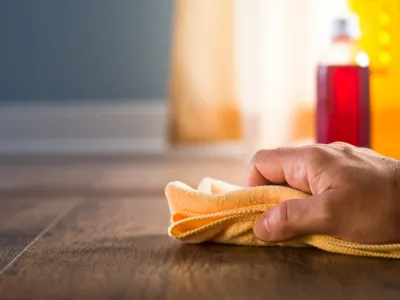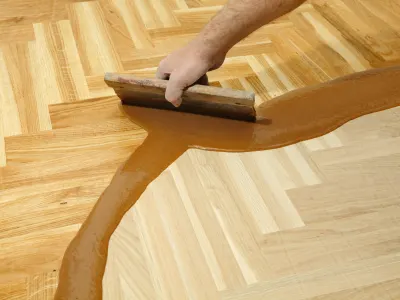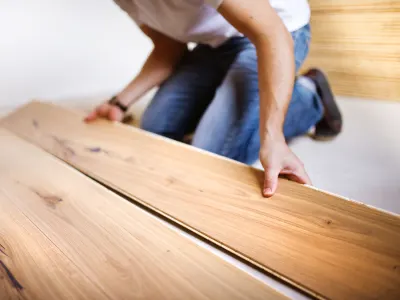Characteristics & Benefits
Finish Options

Finishing new hardwood floors and refinishing old hardwood floors can be a daunting process on its own. When faced with the decision to undergo this type of project, one of the most important decisions is the type of finish to use.
Swedish Floor Finish
Walk away from this old standby! Swedish finish, while extremely durable and strong, has some inherent issues that should make you think twice about allowing it in your home. Swedish hardwood floor finish is usually a 2-part catalyzed, or “acid-cured”, varnish. It is extremely volatile, combustible, and highly toxic. When applying this finish, it is recommended that users wear full-face respirators to avoid breathing or having their mucous membranes exposed to the fumes. Repeated exposure can cause permanent and severe damage to skin, eyes, ears, and respiratory systems, not to mention the cognitive damage that can occur. While manufacturers of Swedish finish have worked hard to lower the VOC (volatile organic compound) content, it is still pretty harsh. Therefore, we at LeBlanc Floors & Interiors DO NOT offer Swedish finish as an option.
Water-based or “waterborne”, urethane floor finish
Water-based floor finishes have been available since the early 1990s but had a very rough start. The products that first came out were extremely difficult to learn and really didn’t offer much durability. Now, water-based urethane floor finish is the most popular option around and has become a leader in durability, flexibility, indoor air quality, and ease of use. There are many brand names out there, but one you may recognize instantly is Bona. Bona Traffic HD has stood out from the pack as the option with the highest solid content of any water-based floor finish. Used in both residential and commercial settings, it is extremely versatile and environmentally friendly. With a VOC level of around 200G/L, this finish is very forgiving during application. It has an odor similar to an interior latex paint and dries extremely fast. Soft foot traffic (socks only!) can be allowed in as little as 4 hours after coating, under the right conditions. We typically recommend at least 12-14 hours because we know that some people will try to push it. This is our most widely applied finish, as it brings the best of all worlds to your new wood floors—beauty, durability, compatibility with almost all wood species, and its low-VOC/ low-toxicity features. Learn more.
Hardwax oil, polyx oil, oil & wax
Hardwax oil finish has been used for treating wood products for centuries. Primarily developed and used in Europe, it offers an environmentally friendly alternative to traditional wood treatments by using natural elements—plant oils and waxes, and often beeswax. Our favorite is Osmo Polyx Oil, the “original” Hardwax oil, but we are well-versed in the use of several similar products such as Rubio Monocoat or Berger Seidle.
Hardwax oils contain natural, rapidly renewable oils sourced from plants. These oils deeply penetrate the wood pores to help retain its elasticity during its natural expansion and contraction. The oils also prevent the wood from drying out or becoming brittle, which lengthens it lifespan. When Hardwax oil is properly applied, moisture will not absorb into the wood—it will bead on the surface and evaporate.
Osmo Polyx Oil is highly versatile and can be used on a variety of wood species and with a variety of wood stains and dyes. Learn more about Osmo products
Refinishing & Restoration

Hardwood flooring adds beauty, durability, and value to any home. If you have hardwood floors, it's a safe bet that you're going to, at some point, require a hardwood floor refinishing. Sanding and finishing hardwood floors will remove decades of wear and abuse to reveal a brand-new layer of natural wood floor that can be stained, resealed, and finish coated for a like-new appearance. In most cases, solid hardwood flooring can be refinished as many as 5-6 times, resulting in a floor that can last over 100 years!
The processes to restore or refinish a hardwood floor are very similar, but not the same thing. Understanding the differences can give you peace of mind about whichever one you need to be carried out. Our hardwood industry training and experience give us a unique perspective on the best option to fit your lifestyle and budget.
Refinishing vs. Restoration — Isn’t it the same?
You might be wondering what the difference is between a hardwood refinish, aka sand and finish, and hardwood floor restoration. Refinishing is a process that can be repeated several times throughout your flooring's lifespan. Years of wear are sanded away to potentially reveal a floor that looks new again. This process allows you to change the color of a floor with stain, choose a new natural-color hardwood sealant, and select a hardwood finish type that matches your current need.
Restoration is most often carried out in historic homes, or homes that have been subjected to damage or abuse for an extended time. In hardwood restoration, board repairs are made, necessary or helpful additions are added, and care is taken to maintain the integrity of as much of the original flooring materials as is possible. The result is a beautiful, finished hardwood floor that looks much like it would have in its original state.
To find out more about what you can expect from a hardwood floor refinish, please contact or visit us to view samples and start working with one of our experienced flooring associates, or you can schedule an in-home consultation!
Installation

Many new materials have been invented over the last 30 years but there is no question that quality, hardwood flooring is timeless. A wood floor installation done by flooring contractors with years of experience could last decades. While products like laminate flooring may have a cheaper price tag in the beginning, wood flooring will pay for itself in not only dollars but in the beauty and quality, it brings into your home.
Making the right choice in the type of hardwood flooring supplies is crucial to getting the best results. There are many options to consider that will make a direct impact on the cost, appearance, and longevity of your new floor.
Wood flooring finish
Thanks to its construction, engineered floors can be installed in areas that solid wood is not typically recommended. The construction of engineered flooring makes it more resistant to warping when exposed to moisture, for instance, making it suitable to install over concrete.
Both products can be resurfaced, meaning that the protective finish on the surface of the floor can be reapplied. However, changing a stain color requires plenty of material to sand through. Most solid wood floors are better suited for color changes because of this.
If one is dedicated to their stain color of choice but may prefer a wider plank width or an exotic species of wood at a lower price, engineered flooring will be the clear winner.
Finally, solid and engineered hardwood flooring are available in both site-finished and prefinished varieties.
Choosing between prefinished and site-finished products will greatly affect your choices of species and stains as well as the overall timeline for installation.
Site-finishing is the traditional way of installing a hardwood floor. Raw wood is installed, sanded with power tools, possibly stained, and then finished with a protective topcoat. This method takes more time and labor but enhances the natural beauty of hardwood. This also allows one to customize a stain color to suit one’s home.
Prefinished hardwood floors are the overwhelming favorite of the new construction industry due to its fast install times and durable, factory finish. The most common species are readily available in a limited palette of stain colors. Resurfacing prefinished hardwood floors requires more aggressive sanding methods while changing stain colors. This can be extremely labor-intensive, if possible at all.
One final note regarding prefinished hardwood flooring. This product is not sanded after installation, as is the case with site-finished floors. To compensate for whatever minor differences in product thickness/height between planks that may exist.
Small bevels are introduced at the edges of the board. These create little “valleys” that trouble some homeowners when maintaining the floor.
Choosing between solid and engineered hardwood flooring will influence cost, timeline, and where the floor can be installed.
As the name implies, solid hardwood flooring is formed out of a single piece of wood with no added layers. Engineered floors, by contrast, are comprised of at least two layers of wood. A top layer made of the chosen species of wood, the middle layer that is high-grade plywood, followed in most cases by a third, bottom wood layer to serve as backing.
Bamboo flooring
Bamboo flooring has gained some popularity in recent times due to its renewability as a natural resource. It’s true that bamboo grows abundantly, however, the process by which it’s made is definitely not natural. A host of chemical binding agents are used to bond the individual strands of grass together. Unless these agents are used in great abundance, the bamboo will remain fairly soft and extremely vulnerable to warping when exposed to moisture.
If you have more specific questions about wood species, visit our Wood Flooring Materials page. Learn about common species such as maple, red oak, and white oak and their characteristics.
If reading customer reviews has left you confused then let us here at LeBlanc assist you with your hardwood floors questions at our full-service showroom in Mukilteo, WA.